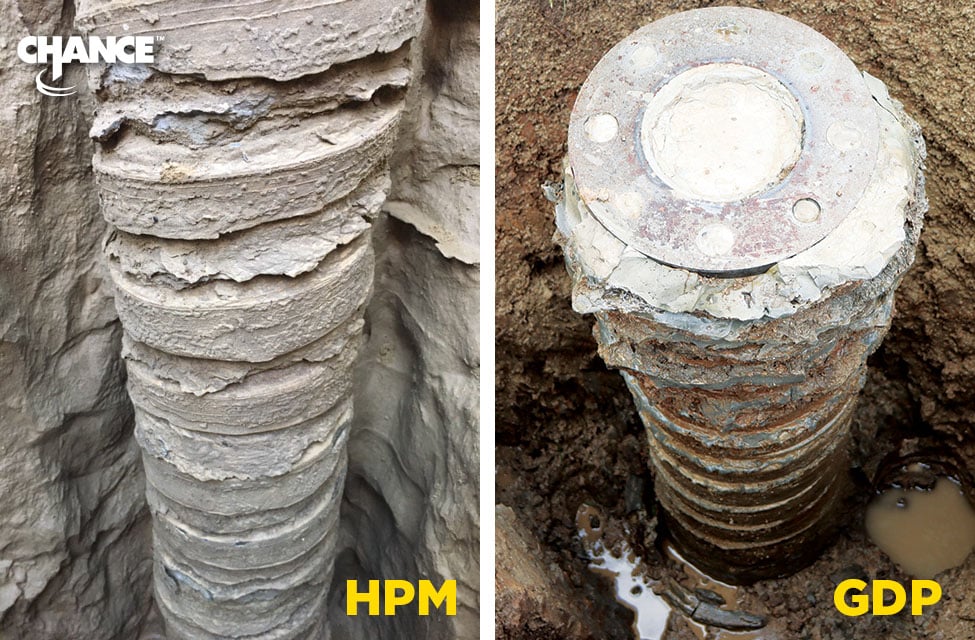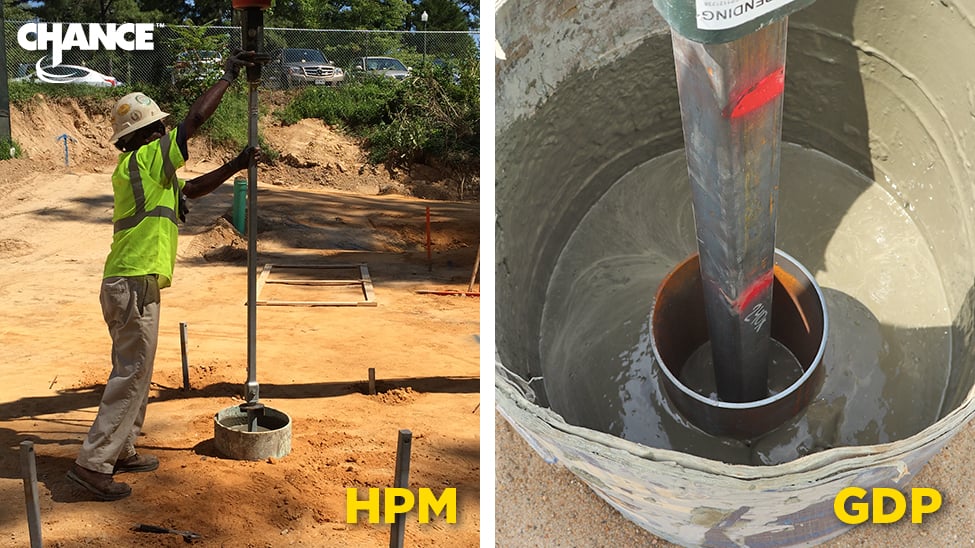Adding grout to a helical pile shaft is a popular option for many reasons. Grout is used to:
- Increase the buckling capacity of a helical pile shaft in soft/loose overburden soils to the point that end bearing controls failure.
- Increase capacity due to the mobilization of skin friction at the grout/soil interface. For Helical Pulldown® piles, total capacity is a function of both skin friction and end bearing. For grouted displacement piles, total capacity is mostly due to skin friction.
- The grout column provides additional corrosion protection from naturally occurring aggressive soils with high metal-loss rates, organic soils such as peat, or other corrosive environments like slag, ash, swamp, chemical waste, or other man-made material.
- Stiffens the load/deflection response . Axial deflection per unit load is typically less than with ungrouted shafts.
 The advantages of grouted displacement piles have long been recognized by engineers, contractors, and manufacturers in the deep foundation industry. Installation benefits include:
The advantages of grouted displacement piles have long been recognized by engineers, contractors, and manufacturers in the deep foundation industry. Installation benefits include:
- No spoils or drill tailings generated – excellent for use where contaminated soil is a concern
- No vibrations or noise – no disturbance to neighboring structures or people!
- Easy to mobilize and install in limited access spaces
- Simple installation with common construction equipment
Increased capacity PLUS all the installation benefits of helical piles? It’s no wonder that this deep foundation innovation has become popular!
A Brief History of Grouted Shaft Piles
As with many innovations in the modern helical pile industry, the Chance team was at the forefront of the technology of grouted shaft piles. Bob Vickars, a Chance Distributor in Canada, patented the grouted helical micropile so helical piles could be used when higher loads were required and when soil conditions raised lateral and buckling concerns.
In 1997, the Chance team released the Helical Pulldown® Micropile (HPM) system. Designed for sites with especially weak surface soils, this innovative application of the helical pile integrates Portland cement–based grout to increase the section properties of the shaft.
In 2017, Chance launched the Drivecast™ screw displacement pile which was recognized by the New York City Department of Design and Construction as a one-for-one substitute for continuous flight auger (CFA) piles. Drivecast displaced soil allowing for a gravity-fed grout column to be created during installation.
In 2024, the Chance team was ready to take grouted piles a step further and received a patent for a “soil displacement pile assembly and method of forming foundation pile” – more commonly known as GroutForce™ displacement pile (GDP).
We will now discuss the differences between Chance’s HPM and the GDP systems.
Helical Pulldown® Micropiles
The HPM is a method of forming a grout column around the shaft of a standard square shaft or pipe shaft helical pile. The result is a helical pile with composite steel and grout shaft similar, in terms of installation, to drilled and grouted anchors or auger cast-in-place piles using gravity grouting. The unique design combines both end-bearing on the helical plates and side resistance along the rough surface of the grout column, which results in a higher capacity pile system (greater than 100 tons possible) which is excellent for weak soil sites with limited access.
The components of a Helical Pulldown Micropile use the standard square shaft or round shaft lead section and plain extensions. They are bolted together in the same manner as a non-grouted helical pile. Displacement plates are used to create an annulus, or void around the shaft by clearing the soil away, which is filled by flowable cement grout. The lead displacement plate follows the lead section. The extension displacement plates are added with each extension to help centralize the steel in the grout column.
GroutForce™ Displacement Piles
GDP is designed for use in loose to dense sand or soft to firm clay and can provide axial capacity of over 500 kip (2224 kN) as well as significant lateral capacity. Since the grout column increases diameter and frictional bond, the shaft length may be reduced by 50% or more versus other pile types while maintaining its high ultimate compression strength.
As the displacement pile is screwed into the ground, the patented casings displace the soil and create a column-shaped void surrounded by compressed soil. A soil plug is created at the beginning of installation, which creates a pulling force that adds up to 2 feet (0.61 m) of hydrostatic head from the weight of the grout, causing the grout to advance into the void very effectively. Due to the effectiveness of the displacement casings, the resulting grout column is free of loose soil, which provides a homogeneous, uncontaminated column. The resulting rough interface with the soil allows for higher load capacities with shorter embedment lengths.
HPM vs GDP – Key Differences
Both the Helical Pulldown Micropile and GroutForce are installed with the same types of tooling and equipment. Both displace soil to create a void that is gravity-fed by grout. So, you may ask (and people do) “Which one do I choose?”
Key Difference #1: Grout Column Depth
One major difference between the HPM and the GDP is where the grout column begins. For the HPM, a displacement plate is added after the lead section is installed. Therefore, the entire lead section is installed in the same manner as a traditional helical pile with no soil displacement or grout column.
GDP, on the other hand, has its first displacement casing welded to the lead helix. During the first part of installation, soil enters the displacement casing through the helix opening, creating a soil plug inside the lead section. A soil retainment plate stops the soil plug from completely filling the displacement casing and creates a pulling force to “suck” the grout into the ground. The soil displacement creates a grout column from the beginning of installation.
Therein lies the key difference. Because the grout column starts at the pile tip, it does not necessarily need to be installed into load-bearing soil stratum. The combination of the soil plug and the larger diameter grout column, allow the installation depth of GroutForce to be terminated at a shallower depth compared to a Helical Pulldown Micropile or an ungrouted pile. For example:
| Product Comparison in Sand |
Scenario 1: |
Scenario 2: |
Scenario 3: |
| SS225 Square Shaft Pile (no grout) |
SS225 Helical Pulldown® Micropile |
SS225 GroutForce™ Displacement Pile |
| Soil |
Uniform medium dense sand with an N value of 10 |
| Installation Depth |
50 ft |
40 ft |
25 ft |
| Installation Torque |
20,000 ft-lb |
16,000 ft-lb |
N/A |
| Ultimate Capacity |
200 kips |
200 kips |
200 kips |
| Product Comparison in Clay |
Scenario 1: |
Scenario 2: |
Scenario 3: |
| SS225 Square Shaft Pile (no grout) |
SS225 Helical Pulldown® Micropile |
SS225 GroutForce™ Displacement Pile |
| Soil |
0 to 40 ft stiff clay N=10, 40 ft to depth stiff clay N=20 |
| Installation Depth |
55 ft |
40 ft |
20 ft |
| Installation Torque |
10,000 ft-lb |
5,000 ft-lb |
N/A |
| Ultimate Capacity |
100 kips |
100 kips |
100 kips |
Key Difference #2: Grout Column Diameter
The Helical Pulldown Micropile utilizes displacement plates to create the grout column. These plates are available in a variety of sizes and types depending on soil type and desired grout column diameter. Plates are available that will result in a grout column from 4” (102 mm) to 7” (178 mm) in diameter when added to a square shaft or pipe shaft Chance helical pile. Again, this grout column will begin at the first extension section after the lead section is installed.
GroutForce is used in conjunction with three standard sizes of Chance helical piles: SS225, RS4500.337, and RS6625.280. The first two will result in a grout column that is 8-5/8” (219 mm) and the third will create a 12-3/4” (324 mm) grout column.
The larger grout column created by GDP results in higher frictional resistance per linear foot of pile embedment due to increased frictional area of the pile. Lateral displacement of the soil during install locally densifies the surrounding soil resulting in increased soil bond strength when comparing to comparable CIP (cast-in-place) pile systems. Increased bond strength results in a smaller diameter pile that can be installed with smaller equipment, no spoils, and comparable axial capacity. When compared with a Helical Pulldown Micropile this can result in shorter pile installations that may yield savings to the contractor and owner.

Key Difference #3: Helical pile vs Displacement Pile
The Helical Pulldown Micropile is a helical pile, meaning it includes a multi-helix configuration to mobilize capacity at the pile tip in a bearing soil stratum. As discussed, the displacement plates are added on the shaft of a standard pile.
The GDP is a screw displacement pile, meaning it displaces soil continuously from the tip up to create a high bond value grouted shaft in soil. It can be used in soil profiles that don’t have any obvious bearing layer(s) but still provide allowable capacities over 200 kip with less overall length.
What to choose when and why
Of course, there’s not a short answer but there are some key questions that will help point you in the right direction:
What is the soil profile?
For HPM, look for soil profiles with soft/loose overburden trending to firm/dense strata suitable for end bearing.
For GroutForce, look for soils that are (1) soft/loose residuals and transported soils over hard/dense tills, weathered rock, sand, gravel, etc. (2) deep soft to medium-stiff clay deposits, or (3) loose to firm urban fill over native in-situ soils. GDP compacts the soil laterally, away from the pile shaft during installation. This densifies and strengthens the surrounding ground.
What capacity do I need?
For Pulldown Piles, you can typically expect a maximum allowable capacity of 200 kip.
For GroutForce, you can expect allowable capacities exceeding 300 kip depending on pile type used and site soil conditions.
GroutForce can replace standard foundation installs of greater than 40 feet and loads over 200 kip. Smaller load requirements should continue to use Helical Pulldown Micropile.
Chance has a nationwide network of distributors and engineers who can help you with your design and product selection questions. Find your local people and get started now!
-

